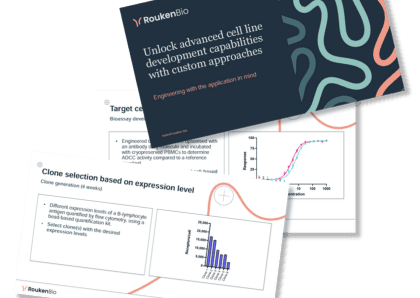Best practices in cell line development - Utilising lentiviruses for cell line engineering
Target cells are a critical component of immune cell effector assays. Whether investigating TDCC or ADCC, we create engineered target cells uniquely suited for the evaluation of effector function and molecule specificity. But how do we achieve this and what are the principles we follow?

|
October 19, 2022
|
6 min read
Understanding target cells
Target cells are a critical component of immune cell effector assays. Whether investigating T cell dependent cellular cytotoxicity (TDCC) or antibody dependent cellular cytotoxicity (ADCC), we create engineered target cells uniquely suited for the evaluation of effector function and molecule specificity. But how do we achieve this and what are the principles we follow?
Cell line engineering using lentiviruses
One of the most efficient techniques for the introduction of genetic information into mammalian cells is the use of replication incompetent lentiviruses (LV). There are three primary reasons our molecular biologists recommend LV for engineering;
- Broad applicability - a wide range of cell types are amenable to transduction, including primary and suspension cells, requiring minimal optimisation.
- High efficiency – LV generally provides a high rate of uptake resulting in a high percentage of transduced cells within a population.
- Low toxicity – cells usually retain high viability and recover quickly from the transduction step. Download our whitepaper to learn more tips and tricks for generating engineered cell lines using lentiviruses.
Real life application to real life challenges
Our specialist teams have experience in generating genetically engineered cell lines for a variety of purposes. In addition to standard cell line production we have created bespoke engineered cell lines to achieve;
- Attenuated and defined levels of gene expression
- Inducible gene expression with fine control and wide dynamic range
- Custom reporter systems to assess signalling pathway contributions
- Reporter assay systems for high throughput screening approaches
- Transduction of difficult to engineer cells, such as primary immune cells e.g. CAR-T
- Novel synthetic construct design; novel reporters, synthetic receptors, tagged proteins, chimeric antigen receptors
- Over-expression of proteins or antibodies
What are lentiviruses?
Lentiviruses are RNA viruses that belong to the family Retroviridae and are capable of transducing dividing and non-dividing cells. They are mainly used as viral vectors which have undergone a series of extensive modifications where all pathogenic and replicative properties have been removed. Lentiviruses are widely used to generate stably expressing mammalian cell lines. Most lentiviral vectors used in gene therapy and in vitro applications are derived from the human immunodeficiency virus (HIV).
Join our community of curious minds on LinkedIn
🗓️ Stay informed with our monthly scientific newsletter, published on LinkedIn on the last Wednesday of each month.
These editions bring you the latest in drug development breakthroughs, industry trends, and expert insights from the brilliant minds at RoukenBio.
Subscribe today on LinkedInDelve into real cell line data
We specialise in creating cell lines for cell-based functional assessments. Our team are experts at generating a variety of genetically engineered cell lines. Learn about best practices by downloading our cell engineering slide deck.
Access our technical slide deck

